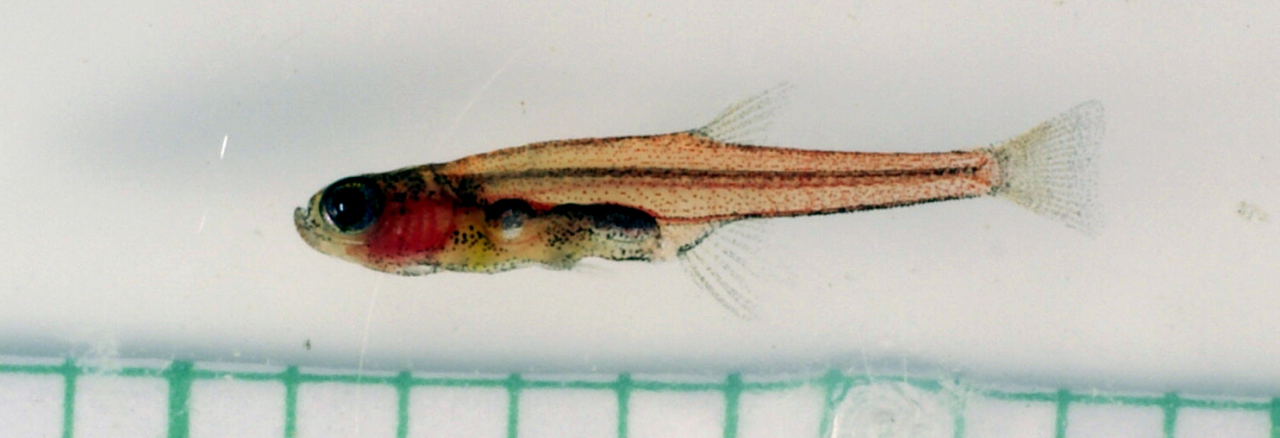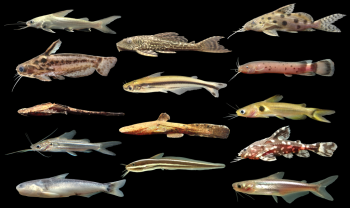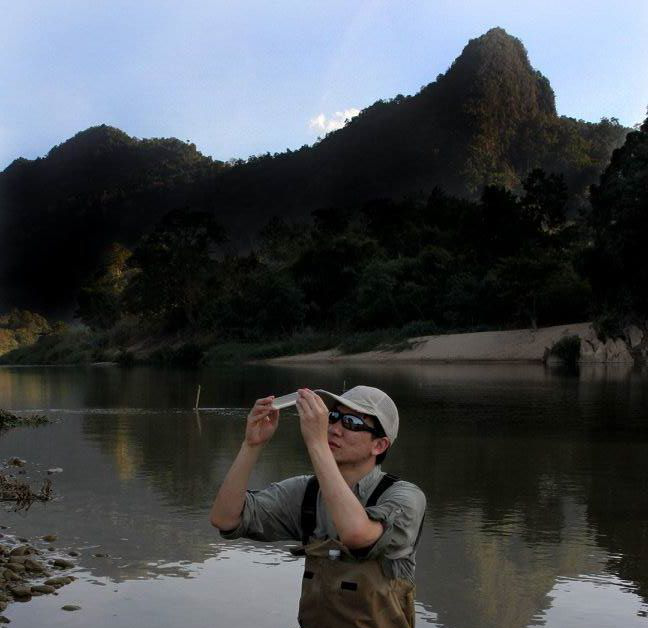Research in the lab focuses on diversity in fishes and their huge variety in species and forms. There are about as many fish species as there are birds, amphibians, reptiles, and mammals combined, so they are an important part of vertebrate diversity. In the lab’s research, we study the evolution of fishes to understand their relationships, the evolution of traits in fishes like body size, and how fishes diversified. To do this, we use genomics and comparative methods to reconstruct evolutionary trees, which then provide a historical framework to reconstruct how genomes and traits evolved.
Evolution and Diversification of Fish Traits

 (Paedocypris photo kindly provided by Rupert Collins).
(Paedocypris photo kindly provided by Rupert Collins).
Modern comparative methods can help us understand the origin and evolution of traits in fishes, including body size, shape, ecology, biogeography, and more. We can also understand why diversification varies across clades, and the relationship that diversification patterns may have to traits. Fishes are morphologically diverse, including extreme variation ranging from miniature fishes in the order Cypriniformes to giants such as the whale shark. In 2024 we were funded by the National Science Foundation to study the evolutionary diversification of the most diverse temperate family of fishes, Leuciscidae, focusing on the North American species. This project integrates phylogenomics, biogeography, and ecology. Other projects in the lab include studying miniaturization in the Cypriniformes, gigantism and longevity in sharks and other vertebrates, and body shape evolution in catfishes. In collaborative works we have also studied the roles of ecology, morphology, and biogeogrpahy in the diversification of other groups such as cichlids, moths, and Neotropical fishes.
Relevant Publications
- 2024. Jemimi Elsherbini, Alexis J Alvey, Corinthia R Black, Ling-Ling S Menez, Milton Tan. Dynamic adaptive evolution and evolutionary modularity and integration in catfishes of the superfamily Doradoidea. Ichthyology & Herpetology.
- 2023. Fernanda A.S. Cassemiro, James S. Albert, Alexandre Antonneli, André Menegetto, Rafael O. Wüest, Felipe Cerezer, Marco Túlio P. Coelho, Roberto E. Reis, Milton Tan, Victor Tagliacollo, Dayani Billy, Valéria F.B. da Silva, Augusto Frota, Weferson J. da Graça, Reginaldo Ré, Telton Ramos, Anielly G. Oliveira, Murilo S. Dias, Robert K. Colwell, Thiago F. Ragel, Catherine H. Graham. Landscape dynamics and diversification of the megadiverse South American freshwater fish fauna. Proceedings of the National Academy of Sciences 120 (2): e2211974120. doi: 10.1073/pnas.2211974120
- 2021. Brett R. Aiello, Milton Tan, Usama Bin Sikandar, Alexis J. Alvey, Burhanuddin Bhinderwala, Katalina C. Kimball, Jesse R. Barber, Chris A. Hamilton, Akito Y. Kawahara, Simon Sponberg. Adaptive shifts underlie the divergence in wing morphology in bombycoid moths. Proceedings of the Royal Society B 288: 20210677. doi: 10.1098/rspb.2021.0677
- 2019. Edward D Burress, Milton Tan, Peter C Wainwright. Head shape modulates diversification of a classic cichlid pharyngeal jaw innovation. American Naturalist 194 (5): 693-706. doi: 10.1086/705392.
- 2018. Edward D Burress, Lubomír Piálek, Jorge R Casciotta, Adriana Almirón, Milton Tan, Jonathan W Armbruster, Oldřich Říčan. Island- and lake-like parallel adaptive radiations replicated in rivers. Proceedings of the Royal Society B 285: 20171762. doi: 10.1098/rspb.2017.1762
- 2017. Edward D Burress, Milton Tan. Ecological opportunity alters the timing and shape of adaptive radiation. Evolution. doi: 10.1111/evo.13362
- 2017. Edward D Burress, Jordan M Holcomb, Milton Tan, JW Armbruster. Ecological diversification associated with the benthic-to-pelagic transition by North American minnows. Journal of Evolutionary Biology 30(3): 549-560. doi: 10.1111/jeb.13024
Phylogenetics of Fishes

Phylogenies represent the evolutionary relationships among species, and are useful in comparative biology for inferring the history of evolution of traits including morphology, ecology, biogeography, and genomes. However, phylogenies are still not well resolved for many diverse groups. Hence, much of the comparative work in the lab is built on a foundation of phylogenetics. Ongoing efforts in the lab focus on reconstructing the phylogenies of diverse clades such as Cypriniformes and Siluriformes. The order Cypriniformes is one of the most diverse groups of fishes, including over 4,000 species of carps, minnows, and their relatives. The catfishes (Order Siluriformes) comprise over 3,000 species of fishes: Roughly one in twenty vertebrate species is a catfish! Phylogenies for these clades will help to establish informed classifications and help reconstruct their evolution and diversification.
Relevant Publications
- 2022. Roberto V. Cucalón, Milton Tan. Divergence times of the group Rhoadsiinae (Characiformes: Characidae). Neotropical Ichthyology 20 (04): e220054. doi: 10.1590/1982-0224-2022-0054
- 2018. Milton Tan, Jonathn W Armbruster. Phylogenetic classification of extant genera of fishes of the order Cypriniformes (Teleostei: Ostariophysi). Zootaxa 4476(1): 006–039. doi: 10.11646/zootaxa.4476.1.4
- 2016. Carla C Stout, Milton Tan (co-first author), Alan R Lemmon, Emily M Lemmon, Jonathan W Armbruster. Resolving Cypriniformes relationships using an Anchored Hybrid Enrichment approach. BMC Evolutionary Biology 16: 244. doi: 10.1186/s12862-016-0819-5
Genomics and Comparative Genomics
 Comparing genomes across the phylogeny can help understand the origin and evolution of genomic and phenotypic traits across species. Much of our lab’s work in comparative genomics has thus far focused on sharks. Despite the wide public interest in sharks, there were no published genomes for any true sharks until we published the whale shark genome, a collaboration between Emory University and Georgia Aquarium that I played a lead role in. Whale sharks are the largest species of fish, and one of the most charismatic fishes in the sea. In ongoing research, we use shark genomes to help us understand the origin and evolution of vertebrates and sharks, and identify unique genomic patterns of evolution that may relate to shark traits. Further comparative genomics research also focuses on the evolution of polyploidy in suckers (family Catostomidae) and other Cypriniformes in collaboration with Dr. Trevor Krabbenhoft.
Comparing genomes across the phylogeny can help understand the origin and evolution of genomic and phenotypic traits across species. Much of our lab’s work in comparative genomics has thus far focused on sharks. Despite the wide public interest in sharks, there were no published genomes for any true sharks until we published the whale shark genome, a collaboration between Emory University and Georgia Aquarium that I played a lead role in. Whale sharks are the largest species of fish, and one of the most charismatic fishes in the sea. In ongoing research, we use shark genomes to help us understand the origin and evolution of vertebrates and sharks, and identify unique genomic patterns of evolution that may relate to shark traits. Further comparative genomics research also focuses on the evolution of polyploidy in suckers (family Catostomidae) and other Cypriniformes in collaboration with Dr. Trevor Krabbenhoft.
Relevant Publications
- 2021. Trevor J. Krabbenhoft, Daniel J. MacGuigan, Nathan J.C. Backenstose, Hannah Waterman, Tianying Lan, Jessie A. Pelosi, Milton Tan, Simen R. Sandve. Chromosome-level genome assembly of Chinese sucker (Myxocyprinus asiaticus) reveals strongly-conserved synteny following a catostomid-specific whole genome duplication. Genome Biology and Evolution. doi: 10.1093/gbe/evab190.
- 2021. Milton Tan, Anthony K. Redmond, Helen Dooley, Ryo Nozu, Keiichi Sato, Shigehiro Kuraku, Sergey Koren, Adam M. Phillippy, Alistair D.M. Dove, Timothy D. Read. The whale shark genome reveals patterns of vertebrate gene family evolution. eLife 10:e65394. doi: 10.7554/eLife.65394.
- 2021. Gayle K McEwen, David E Alquezar-Planas, Anisha Dayaram, Amber Gillett, Rachael Tarlinton, Nigel Mongan, Keith J Chappell, Joerg Henning, Milton Tan, Peter Timms, Paul R Young, Alfred L Roca, Alex D Greenwood. Frequent retroviral integrations contribute to elevated host cancer rates during germline invasion. Nature Communications 12: 1316. doi: 10.1038/s41467-021-21612-7
- 2021. Andrew D Sweet, Kevin P Johnson, Yanghui Cao, Robert S de Moya, Rachel K Skinner, Milton Tan, Stephany Virrueta Herrera, Stephen L Cameron. Structure, gene order, and nucleotide composition of mitochondrial genomes in parasitic lice from Amblycera. Gene. doi: 10.1016/j.gene.2020.145312.
- 2017. Timothy D Read, Robert A Petit III, Sandeep J Joseph, Md Tauqeer Alam, M Ryan Weil, Maida Ahmad, Ravila Bhimani, Jocelyn S Vuong, Chad P Haase, D Harry Webb, Milton Tan (corresponding author), Alistair DM Dove. Draft sequencing and assembly of the genome of the world’s largest fish, the whale shark: Rhincodon typus Smith 1828. BMC Genomics 18: 532. doi: 10.1186/s12864-017-3926-9
Population Genomics
Populations of species, their genetic diversity, and how they connect or separate all also relate to ultimately explaining diversity of species across the landscape. In ongoing work, we are using population genomics to understand the diversity of fishes and other species, especially the identification of population structure and even potential cryptic species.
Relevant Publications
- 2024. Roberto V Cucalón, Joel B Corush, Matthew L Niemiller, Amanda N Curtis, Pamela B Hart, Bernard R Kuhajda, Matthew R Thomas, Brian Metzke, Mark A Davis, Milton Tan. Population Genomics and Mitochondrial DNA Reveal Cryptic Diversity in North American Spring Cavefishes (Amblyopsidae, Forbesichthys). Conservation Genetics. doi: 10.1007/s10592-024-01640-8
- 2022. Matthew L. Niemiller, Mark A. Davis, Milton Tan, J.J. Apodaca, Katherine E. Dooley, Robert V. Cucalón, Joseph B. Benito, K. Denise Kendall Niemiller, Rebecca H. Hardman, Daniel Istvanko, Dustin Thames. Mitochondrial DNA and population genomics reveal additional cryptic diversity in the Green Salamander (subgenus Castaneides) species complex. Frontiers in Conservation Science 3: 890859. doi: 10.3389/fcosc.2022.890859.
Fieldwork and Collections
 Part of what makes research so exciting is to be able to get out into the field to catch fishes! I have been lucky to have numerous field experiences, including in the United States, Suriname, Thailand, and Peru. Catching fish isn’t just stamp collecting, specimens serve as a primary source of data to understand what species are out there, where they’re found, and what their genes and genomes are like. Specimens that I have collected have been preserved and stored in natural history collections at the Illinois Natural History Survey, Auburn University, and the Florida Museum of Natural History. Continued support of fieldwork and maintenance of natural history collections are needed to continue to grow data necessary to address great challenges. In the photo, I am inspecting a vial of larval fishes I had just collected in the Salween River of Thailand, under the shadow of the mountains that form the border on the Myanmar side. (Photo by Zach Randall).
Part of what makes research so exciting is to be able to get out into the field to catch fishes! I have been lucky to have numerous field experiences, including in the United States, Suriname, Thailand, and Peru. Catching fish isn’t just stamp collecting, specimens serve as a primary source of data to understand what species are out there, where they’re found, and what their genes and genomes are like. Specimens that I have collected have been preserved and stored in natural history collections at the Illinois Natural History Survey, Auburn University, and the Florida Museum of Natural History. Continued support of fieldwork and maintenance of natural history collections are needed to continue to grow data necessary to address great challenges. In the photo, I am inspecting a vial of larval fishes I had just collected in the Salween River of Thailand, under the shadow of the mountains that form the border on the Myanmar side. (Photo by Zach Randall).
Relevant Publications
- 2020. Sara E Miller, Lisa N Barrow, Sean M Ehlman, Jessica A Goodheart, Stephen E Greiman, Holly L Lutz, Tracy M Misiewicz, Stephanie M Smith, Milton Tan, Christopher J Thawley, Joseph A Cook, Jessica E Light. Building natural history collections for the 21st century and beyond. BioScience 70(8): 674-687. doi: 10.1093/biosci/biaa069.
- 2014. C Keith Ray, Milton Tan, & Jonathan W Armbruster. First record of Chrosomus erythrogaster (Cypriniformes: Cyprinidae) in the Mobile Basin. Southeastern Naturalist 13(4): N33-N36. doi: 10.1656/058.013.0402
Taxonomy of Fishes
 Many species remain unknown to science. For scientists to understand how biodiversity arose and the evolution of biodiversity, we must understand what is out there. Furthermore, the classification of these species provides the foundation for the understanding of the diversity of species. I have helped describe numerous new species of catfishes from South America. Pictured is a new species that we described, Peckoltia greedoi, photo by Jonathan Armbruster. I have also contributed to the classification of species that are part of the Order Cypriniformes.
Many species remain unknown to science. For scientists to understand how biodiversity arose and the evolution of biodiversity, we must understand what is out there. Furthermore, the classification of these species provides the foundation for the understanding of the diversity of species. I have helped describe numerous new species of catfishes from South America. Pictured is a new species that we described, Peckoltia greedoi, photo by Jonathan Armbruster. I have also contributed to the classification of species that are part of the Order Cypriniformes.
Relevant Publications
- 2018. Milton Tan, Jonathan W Armbruster. Phylogenetic classification of extant genera of fishes of the order Cypriniformes (Teleostei: Ostariophysi). Zootaxa 4476(1): 006–039. doi: 10.11646/zootaxa.4476.1.4
- 2016. Milton Tan, Lesley S de Souza, Jonathan W Armbruster. A new species of Panaqolus (Siluriformes: Loricariidae) from the rio Branco. Neotropical Ichthyology 14(2): e150033. doi: 10.1590/1982-0224-20150033
- 2016. Milton Tan, Jonathan W Armbruster. Two new species of spotted Hypancistrus from the Rio Negro Drainage (Loricariidae, Hypostominae). ZooKeys 552: 123-135. doi: 10.3897/zookeys.552.5956
- 2015. Jonathan W Armbruster, David C Werneke, Milton Tan. Three new species of saddled loricariid catfishes, and a review of Hemiancistrus, Peckoltia, and allied genera (Siluriformes). ZooKeys 480: 97-123. doi: 10.3897/zookeys.480.6540
- 2012. Milton Tan, Jonathan W Armbruster. Cordylancistrus santarosensis (Siluriformes: Loricariidae), a new species with unique snout deplatation from the Río Santa Rosa, Ecuador. Zootaxa 3243:52-58.
